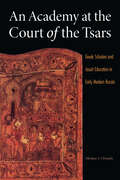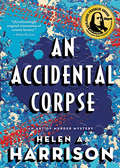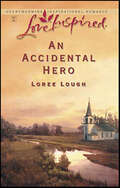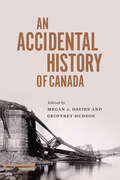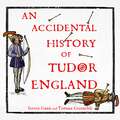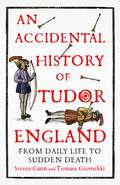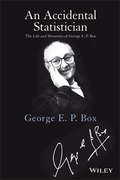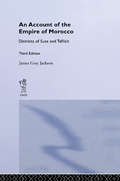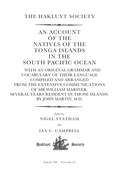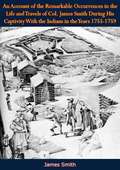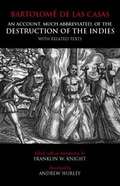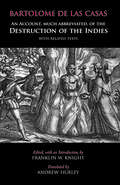- Table View
- List View
An Academy at the Court of the Tsars: Greek Scholars and Jesuit Education in Early Modern Russia (NIU Series in Slavic, East European, and Eurasian Studies)
by Nikolaos A. ChrissidisThe first formally organized educational institution in Russia was established in 1685 by two Greek hieromonks, Ioannikios and Sophronios Leichoudes. Like many of their Greek contemporaries in the seventeenth century, the brothers acquired part of their schooling in colleges of post-Renaissance Italy under a precise copy of the Jesuit curriculum. When they created a school in Moscow, known as the Slavo-Greco-Latin Academy, they emulated the structural characteristics, pedagogical methods, and program of studies of Jesuit prototypes. In this original work, Nikolaos A. Chrissidis analyzes the academy's impact on Russian educational practice and situates it in the contexts of Russian-Greek cultural relations and increased contact between Russia and Western Europe in the seventeenth century. Chrissidis demonstrates that Greek academic and cultural influences on Russia in the second half of the seventeenth century were Western in character, though Orthodox in doctrinal terms. He also shows that Russian and Greek educational enterprises were part of the larger European pattern of Jesuit academic activities that impacted Roman Catholic and Eastern Orthodox educational establishments and curricular choices. An Academy at the Court of the Tsars is the first study of the Slavo-Greco-Latin Academy in English and the only one based on primary sources in Russian, Church Slavonic, Greek, and Latin. It will interest scholars and students of early modern Russian and Greek history, of early modern European intellectual history and the history of science, of Jesuit education, and of Eastern Orthodox history and culture.
An Academy for Liars
by Alexis HendersonA student will find that the hardest lessons sometimes come from outside the classroom in this stunning dark academia novel from the acclaimed author of The Year of the Witching and House of Hunger.Lennon Carter&’s life is falling apart. Then she gets a mysterious phone call inviting her to take the entrance exam for Drayton College, a school of magic hidden in a secret pocket of Savannah. Lennon has been chosen because—like everyone else at the school—she has the innate gift of persuasion, the ability to wield her will like a weapon, using it to control others and, in rare cases, matter itself. After passing the test, Lennon begins to learn how to master her devastating and unsettling power. But despite persuasion&’s heavy toll on her body and mind, she is wholly captivated by her studies, by Drayton&’s lush, moss-draped campus, and by her brilliant classmates. But even more captivating is her charismatic adviser, Dante, who both intimidates and enthralls her. As Lennon continues in her studies, her control grows, and she starts to uncover more about the secret world she has entered into, including the disquieting history of Drayton College. She is increasingly disturbed by what she learns, for it seems that the ultimate test is to embrace absolute power without succumbing to corruption...and it&’s a test she&’s terrified she&’s going to fail.
An Accident in Paris: The stunning new Princess Diana conspiracy thriller you won't be able to put down
by Gavin Collinson'Absolutely fascinating . . . A fantastic read' – BBC Radio London 'Remarkable' – BBC Radio BerkshireEver wondered what really happened to Princess Diana? Then this gripping new conspiracy thriller is for you. ___________August 1997: A princess dies in Paris.When private investigator Marc Novak is hired to investigate what – and who – really caused the death of Princess Diana, the last thing he expects to discover is a brutal, covert world.But soon he's drawn head-to-head with people so powerful, they'll kill to protect their secrets. To them, murder is legal and the truth can be tailored to suit the highest bidder.25 years on, could it be that the fatal crash wasn't just an accident in Paris?'Gavin Collinson has created a thriller which is both suspenseful and funny as well as interesting' Bella ___________What readers are saying about An Accident in Paris:????? 'Slick and gripping'????? 'Fast moving and thought provoking'????? 'Whip smart'????? 'Pacy and high-octane conspiracy thriller'????? 'Intriguing and great fun'
An Accidental Corpse (Art of Murder Mysteries #2)
by Helen HarrisonAccidents happen. But so does murder...On the night of August 11, 1956, in a quiet East Hampton hamlet, Jackson Pollock crashed his car into a tree. The accident killed Pollock, the world-renowned abstract painter and notorious alcoholic, and his 25-year old passenger, Edith Metzger...or did it?Metzger's autopsy reveals that she was already dead before the crash. Was it murder?This shocking question draws vacationing Detective Juanita Diaz and her husband, Captain Brian Fitzgerald, of the NYPD into a homicide investigation that implicates famous members of East Hampton's art community—including Pollock himself."Edifying and juicy."—Newsday
An Accidental Hero
by Loree LoughA head-on collision with burned-out rodeo star Reid Alexander is the last thing actress Cammi Carlisle needs! Pregnant, widowed and considered a "has-been," Cammi is returning to her family's Texas ranch in search of forgiveness. Little does she know that Reid wants her forgiveness....Though there's sizzling chemistry between them, Reid knows a relationship would never work. Unbeknownst to Cammi, Reid was the one driving the pickup that killed her mother years ago. Even though it was a tragic accident with no one at fault, how will she ever forgive him when he can't even forgive himself?
An Accidental Hero & An Accidental Mom
by Loree LoughLoree Lough shares stories of love, faith and healing.An Accidental HeroStruggling actress Cammi Carlisle is leading a life of bad luck. When fate throws her and Reid Alexander together, though, things start to look up. Still, Reid harbors a terrible secret that the pregnant Cammi may not be able to forgive....An Accidental MomAny glimpse of Max Sheridan, her long-lost love, has always made Lily London sparkle. Then Max, now a widower, returns to Amarillo with his young son. Max doesn't think the girl he left behind can handle a ready-made family-it's up to Lily to prove him wrong.
An Accidental History of Canada (McGill-Queen's/AMS Healthcare Studies in the History of Medicine, Health, and Society)
by Megan J. Davies and Geoffrey L. HudsonAlthough Canadian history has no shortage of stories about disasters and accidents, the phenomena of risk, upset, and misfortune have been largely overlooked by historians. Disasters get their due, but not so the smaller-scale accident where fate is more intimate. Yet such events often have a vivid afterlife in the communities where they happen, and the way in which they are explained and remembered has significant social, cultural, and political meaning.An Accidental History of Canada brings together original studies of an intriguing range of accidents stretching from the 1630s to the 1970s. These include workplace, domestic, childhood, and leisure accidents in colonial, Indigenous, rural, and urban settings. Whether arising from colonial power relations, urban dangers, perils in resource extraction, or hazardous recreations, most accidents occur within circumstances of vulnerability, and reveal precarity and inequities not otherwise apparent. Contributors to this volume are alert to the intersections of the settler agenda and the elevation of risk that it brings. Indigenous and settler ways of understanding accidents are juxtaposed, with chapters exploring the links between accidents and the rise of the modern state.An Accidental History of Canada makes plain that whether they are interpreted as an intervention by providence, a miscalculation, an inevitability, or the result of observable risk, accidents – and our responses to them – reveal shared values.
An Accidental History of Tudor England: From Daily Life to Sudden Death
by Steven Gunn Tomasz GromelskiA unique new window onto Tudor life, told through ordinary people's untimely deaths. How did ordinary people live in Tudor England? This unique history unearths the ways they died to find out. Uncovering thousands of coroners' reports, An Accidental History of Tudor England explores the history of everyday life, and everyday death, in a world far from the intrigues of Hampton Court Palace, Shakespeare's plots and the Spanish Armada. Here, farming, building and travel were dangerous. Fruit trees killed more people than guns, and sheep killed about the same number as coalmines. Men stabbed themselves playing football and women drowned in hundreds fetching water. Going to church had its dangers, especially when it came to bell-ringing, archery practice was perilous and haystacks claimed numerous victims. Restless animals roamed the roads which contained some potholes so deep men could drown, and drown they did.From bear attacks in north Oxford to a bowls-on-ice-incident on the Thames, this book uses a remarkable trove of sources and stories to put common folk back into the big picture of Tudor England, bringing the reality of their world to life as never before.
An Accidental History of Tudor England: From Daily Life to Sudden Death
by Steven Gunn Tomasz GromelskiA unique new window onto Tudor life, told through ordinary people's untimely deaths. How did ordinary people live in Tudor England? This unique history unearths the ways they died to find out. Uncovering thousands of coroners' reports, An Accidental History of Tudor England explores the history of everyday life, and everyday death, in a world far from the intrigues of Hampton Court Palace, Shakespeare's plots and the Spanish Armada. Here, farming, building and travel were dangerous. Fruit trees killed more people than guns, and sheep killed about the same number as coalmines. Men stabbed themselves playing football and women drowned in hundreds fetching water. Going to church had its dangers, especially when it came to bell-ringing, archery practice was perilous and haystacks claimed numerous victims. Restless animals roamed the roads which contained some potholes so deep men could drown, and drown they did.From bear attacks in north Oxford to a bowls-on-ice-incident on the Thames, this book uses a remarkable trove of sources and stories to put common folk back into the big picture of Tudor England, bringing the reality of their world to life as never before.
An Accidental Seduction
by Lois GreimanWhen she submits, heart and body, to the rogue's desires, it will be no accident. . .
An Accidental Seduction
by Michelle WillinghamEmily Barrow once dreamed that she could marry Stephen Chesterfield, The Earl of Whitmore, and be saved from her dreary life. Then Stephen's father sent him away, leaving Emily broken-hearted... Now Stephen has returned to find Emily destitute and alone. He has vowed to help her without compromising her honor... but Emily has other ideas. She doesn't want his charity, but she does long to know what it would be like to take him as a lover, even if marriage is out of the question. Confined to close quarters with their passion burning as brightly as ever, will Stephen be able to resist the temptation and rescue her, or give in to his desire and completely ruin her? A prequel to The Accidental Countess by Michelle Willingham.
An Accidental Seduction
by Michelle WillinghamOne night to live her fantasies… Emily Barrow once dreamed of marrying Stephen Chesterfield, the Earl of Whitmore, to save her from her dreary life. Their union is impossible, but even so, she longs to discover what it would be like to spend the night in Stephen's arms… Stephen is determined to resist the attraction he feels toward Emily—he won't ruin her when he cannot marry her! But then, a snowstorm leaves them trapped together, and it's not long before they succumb to their inescapable passion! A short prequel to THE ACCIDENTAL COUNTESS by bestselling author Michelle Willingham, originally published in 2010
An Accidental Statistician
by George E. BoxCelebrating the life of an admired pioneer in statisticsIn this captivating and inspiring memoir, world-renowned statistician George E. P. Box offers a firsthand account of his life and statistical work. Writing in an engaging, charming style, Dr. Box reveals the unlikely events that led him to a career in statistics, beginning with his job as a chemist conducting experiments for the British army during World War II. At this turning point in his life and career, Dr. Box taught himself the statistical methods necessary to analyze his own findings when there were no statisticians available to check his work.Throughout his autobiography, Dr. Box expertly weaves a personal and professional narrative to illustrate the effects his work had on his life and vice-versa. Interwoven between his research with time series analysis, experimental design, and the quality movement, Dr. Box recounts coming to the United States, his family life, and stories of the people who mean the most to him.This fascinating account balances the influence of both personal and professional relationships to demonstrate the extraordinary life of one of the greatest and most influential statisticians of our time. An Accidental Statistician also features:* Two forewords written by Dr. Box's former colleagues and closest confidants* Personal insights from more than a dozen statisticians on how Dr. Box has influenced and continues to touch their careers and lives* Numerous, previously unpublished photos from the author's personal collectionAn Accidental Statistician is a compelling read for statisticians in education or industry, mathematicians, engineers, and anyone interested in the life story of an influential intellectual who altered the world of modern statistics.
An Accidental Villain: A Soldier's Tale of War, Deceit and Exile
by Linden MacIntyreFrom the bestselling, prize-winning author Linden MacIntyre comes an engrossing, page-turning exploration of the little-known life of Sir Hugh Tudor. Appointed by his friend Winston Churchill to lead the police in Ireland during the Irish War of Independence, Tudor met civil strife and domestic terrorism with indiscriminate state-sanctioned murder—changing the course of Irish history.After distinguishing himself on the battlefields of the First World War, Major-General Sir Hugh Tudor could have sought a respectable retirement in England, his duty done. But in 1920, his old friend Winston Churchill, Minister of War in Lloyd George&’s cabinet, called on Tudor to serve in a very different kind of conflict—one fought in the Irish streets and countryside against an enemy determined to resist British colonial authority to the death. And soon Tudor was directing a police force waging a brutal campaign against rebel &“terrorists,&” one he was determined to win at all costs—including utilizing police death squads and inflicting brutal reprisals against IRA members and supporters and Sinn Féin politicians.Tudor left few traces of his time in Ireland. No diary or letters that might explain his record as commander of the notorious Black and Tans. Nothing to justify his role in Bloody Sunday, November 21, 1920, when his men infamously slaughtered Irish football fans. And why did a man knighted for his efforts in Ireland leave his family and homeland in 1925, moving across the sea to Newfoundland?Linden MacIntyre has spent four years tracking Tudor through archives, contemporaries&’ diaries and letters, and the body count of that Irish war. In An Accidental Villain, he delivers a consequential and fascinating account of how events can bring a man to the point where he acts against his own training, principles and inclination in the service of a cause—and ends up on a long journey toward personal oblivion.
An Account of Egypt
by HerodotusAn Account of Egypt is the story of Greek historian Herodotus' travels through the Ptolemaic Kingdom.It is a richly descriptive tale of ancient Egyptian customs, rituals and daily life from the legendary writer whom Cicero labeled ‘The Father of History.’
An Account of the British Settlement of Aden in Arabia
by F.M. HunterFirst Published in 1968. Routledge is an imprint of Taylor & Francis, an informa company.
An Account of the Corvette: L'Uraine's Sojourn at the Mariana Islands, 1819
by Louis Claude FreycinetLike his Russian contemporary Otto von Kotzebue, who preceded him at Guam by sixteen months (November 1817) and with a comparable mix of reprovisioning and scientific aims, Louis Claude de Freycinet (1779-1842) of L'Uranie (ex-Ciotat) came to the Mariana Islands as a veteran of mid-Pacific exploration. Captain Kruzenshtern's Nadezhda had been Kotzebue's "floating academy" in 1803-06, while Freycinet had - with his elder brother Henri -sailed with Baudin in the celebrated Geographe and Naturaliste to Australasia and a possible collision with the British. As an officer of literary bent. Ensign de Freycinet maintained a journal on the strength of which he afterwards became the Baudin expedition's somewhat partial annalist. His sober temperament and naval competence, together with a wide spectrum of scientific interests, lent real importance to the record of his three-month stay on Guam (17 March - 6 June 1819) large parts of which are offered here in English for the first time.
An Account of the Empire of Morocco and the Districts of Suse and Tafilelt
by James Grey JacksonFirst published in 1814, this is an account "Compiled from Miscellaneous Observations Made During a Long Residence in, and Various Journeys Through, These Countries. To which is Added An Account of Shipwrecks on the Western Coast of Africa and an Interesting Account of Timbuctoo.
An Account of the Natives of the Tonga Islands in the South Pacific Ocean (Hakluyt Society, Third Series)
by Ian C. Campbell Nigel StathamJohn Martin (1789-1869) was a London-based, Edinburgh-educated physician interested in anthropological matters. This is his only book. He was inspired to write it by a chance encounter with its subject, William Mariner (1791-1853) who spent four years (1806-1810) in Tonga, in the South Pacific, one of the earliest European residents at a time before European influence disturbance or modification society. Mariner, an extraordinarily mature and perceptive youth, became thoroughly imbued with Tongan language and culture as the adopted son of the most powerful chief in Tonga. Thanks to Martin’s intelligent engagement with Mariner resulted in a compelling narrative and a comprehensive account of Tongan society which became a classic. Often celebrated as an extraordinary real-life adventure story, it is a pioneering work of anthropology, and for 200 years it has been a primary and authoritative source for research into Tongan history and culture.
An Account of the Remarkable Occurrences in the Life and Travels of Col. James Smith: During His Captivity With the Indians in the Years 1755-1759
by James SmithThe present volume, which was first published in 1799, is the autobiography of frontiersman Col. James Smith, together with an analysis of Indian culture. The book gives an account of the remarkable occurrences in the life and travels of Col. James Smith (later a citizen of Bourbon County, Kentucky), during his captivity with the Indians, in the years 1755, 1756, 1757, 1758, and 1759. It was written by Col. Smith himself.The book provides, for the first time by any author, a full account of the customs, manners, traditions, theological sentiments, mode of warfare, military tactics, discipline and encampments, treatment of prisoners, and so on. It also includes a detailed description of the soil, timber and waters, where Col. Smith travelled with the Indians, and during his captivity, and further provides a brief account of some very uncommon occurrences, which transpired after his return from captivity.Finally, the book describes in depth the different campaigns carried on against the Indians to the westward of Fort Pitt, since the year 1755, up to 1799.
An Account, Much Abbreviated, of the Destruction of the Indies
by Bartolome de las CasasFifty years after the arrival of Columbus, at the height of Spain's conquest of the West Indies, Spanish bishop and colonist Bartolomé de las Casas dedicated his Brevísima Relación de la Destruición de las Indias to Philip II of Spain.
An Account, Much Abbreviated, of the Destruction of the Indies: And Related Texts
by Andrew Hurley Franklin W. Knight Bartolomé de las CasasFifty years after the arrival of Columbus, at the height of Spain's conquest of the West Indies, Spanish bishop and colonist Bartolomé de Las Casas dedicated his Brevísima Relación de la Destruición de las Indias to Philip II of Spain. An impassioned plea on behalf of the native peoples of the West Indies, the Brevísima Relación catalogues in horrific detail atrocities it attributes to the king's colonists in the New World. The result is a withering indictment of the conquerors that has cast a 500-year shadow over the subsequent history of that world and the European colonization of it.
An Ace of the Eighth
by Norman J. FortierFOR A FIGHTER PILOT IN THE MIGHTY EIGHTH, DEATH WAS ALWAYS A HEARTBEAT AWAY. When the skies of Europe blazed with the fiercest air battles in history, fighter pilots like Norman “Bud” Fortier were in the thick of it, flying four hundred miles an hour at thirty thousand feet, dodging flak and dueling with Nazi aces. In their role as “escorts” to Flying Fortresses and Liberators, the fighter squadrons’ ability to blast enemy aircraft from the sky was key to the success of pinpoint bombing raids on German oil refineries, communication and supply lines, and other crucial targets. Flying in formation with the bomber stream, Fortier and the rest of his squadron helped develop dive-bombing and strafing tactics for the Thunderbolts and Mustangs. As the war progressed, fighter squadrons began to carry out their own bombing missions. From blasting V-1 missile sites along France’s “rocket coast” and the hell-torn action of D day to the critical attacks on the Ruhr Valley and massive daylight raids on German industrial targets, Fortier was part of the Allies’ bitter struggle to bring the Nazi war machine to a halt. In describing his own hundred-plus missions and by including the accounts of fellow fighter pilots, Fortier recaptures the excitement and fiery terror of the world’s most dangerous cat-and-mouse game. From the Paperback edition.
An Acquaintance with Darkness (Great Episodes)
by Ann RinaldiFourteen-year-old Emily Pigbush suspects that her uncle is involved in body snatching. Meanwhile, her best friend's family is accused of plotting to kill Abraham Lincoln, and Emily is left unsure of whom she can trust. Includes a reader's guide.
An Act Of Courage: (The Matthew Hervey Adventures: 7): A compelling and unputdownable military adventure from bestselling author Allan Mallinson (Matthew Hervey #7)
by Allan MallinsonTHE SUNDAY TIMES BESTSELLING AUTHOR Allan Mallinson brings us another compelling and deeply atmospheric adventure featuring Matthew Hervey. If you like Patrick O'Brian, Bernard Cornwell and CS Forester, you will love this! "Most impressive...Mallinson reinforces his position as a master of narrative military history" -- THE TIMES"As good on the details of the workings of a cavalry regiment in 1820 as ever Patrick O'Brian was on the workings of an 1820 warship" -- SPECTATOR"What a pleasure...concentrating on the battle of Talavera and the investment of Badajoz, both sparklingly described, he plays to his undoubted strengths" - OBSERVER"The atmosphere and authenticity continues to work its spell all the way through." -- ***** Reader review"Highly enjoyable novel. Great story. Thoroughly recommend for lovers of adventure novels." -- ***** Reader review"A truly outstanding read" -- ***** Reader review *********************************************************Badajoz: Christmas 1826Matthew Hervey of the 6th Light Dragoons is a prisoner of the Spanish, incarcerated in the infamous fortress of Badajoz.As he plans his escape, his thoughts return to the year 1812 when he was a cornet in Wellington's Peninsular Army. He and the Sixth had survived Corunna to endure three more years of brutal fighting that would culminate in one of the most vital and vicious confrontations of the campaign - the siege of Badajoz.While Hervey paces his prison cell, and re-lives the bloodshed of battles past, friends from unexpected quarters rush to his aid...An Act of Courage is the seventh book in Allan Mallinson's Matthew Hervey series. His adventures continue in Company of Spears. Have you read his previous adventures A Close Run Thing, The Nizam's Daughters, A Regimental Affair, A Call to Arms, The Sabre's Edge and Rumours of War?
